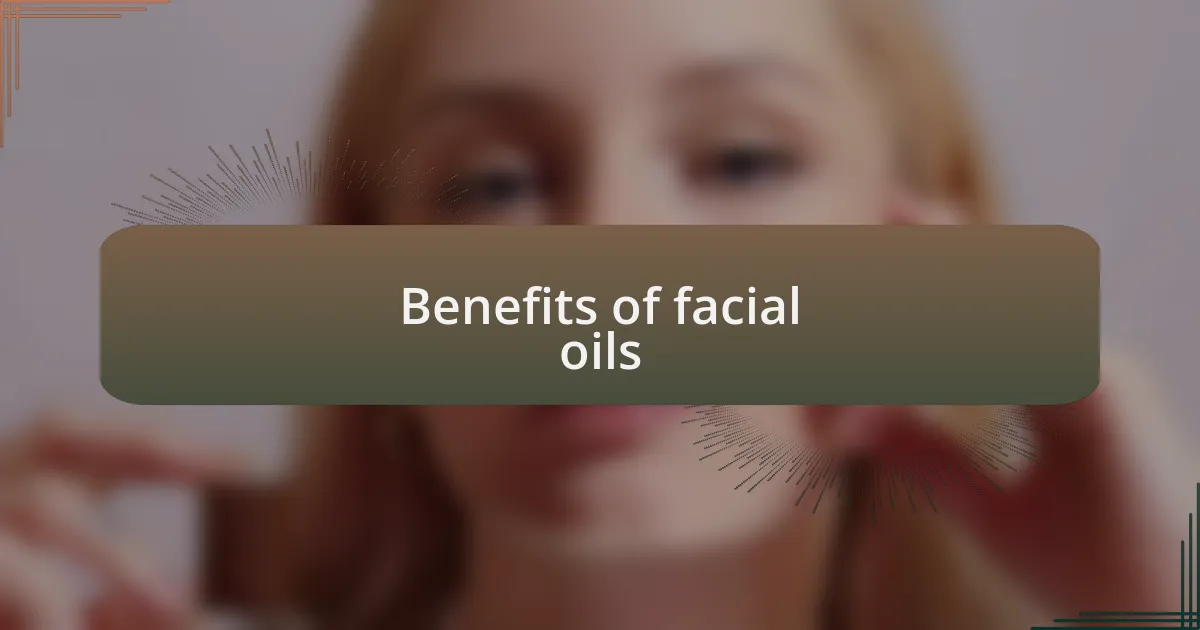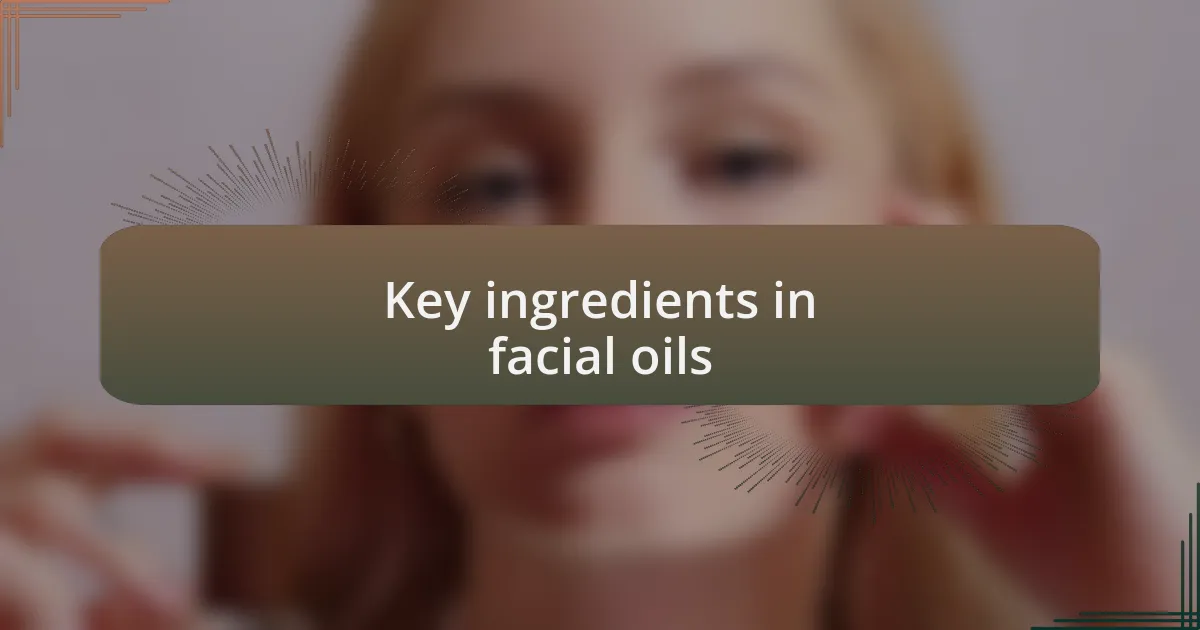Key takeaways:
- Facial oils offer unique benefits depending on their source, such as hydration, nourishment, and soothing properties for various skin types.
- Key ingredients like jojoba and rosehip oil can balance oil production and address skin concerns like fine lines and uneven texture.
- The testing process reveals that individual oils can have distinct effects on skin, emphasizing the importance of personal experience in selecting the right product.
- Experimenting with blending different oils allows for a personalized skincare routine that adapts to seasonal needs and enhances overall skin health.

Understanding facial oils
Facial oils are more than just a skincare trend; they are a powerhouse of nourishment for the skin. I remember my first application—how the rich texture instantly transformed my dry patches into supple, glowing skin. Have you ever experienced such a profound change with a single product? It’s like discovering a secret ingredient for your skincare routine.
These oils come from various sources, such as nuts, seeds, and fruits, each offering unique benefits. For instance, I found that rosehip oil worked wonders for my scars and fine lines, while jojoba oil mimicked the skin’s natural sebum, balancing oil production. It’s fascinating how understanding the origin of these oils can deepen our appreciation for their effects.
Exploring the world of facial oils also means recognizing their versatility. I often mix a few drops with my moisturizer for an added boost or apply them directly for that extra glow. Have you tried layering oils? It can be a game changer, bringing hydration and brightness in a way that feels luxurious yet accessible.

Benefits of facial oils
Facial oils bring a wealth of benefits that can elevate any skincare routine. I recall a time when my skin felt particularly dull and lifeless, but after incorporating facial oils, the transformation was remarkable. They not only hydrate but also lock in moisture, making my skin look plump and radiant throughout the day. Have you ever seen a product work so efficiently in such a short time?
One of the standout advantages of these oils is their ability to nourish the skin deeply. When I started using argan oil, I noticed it helped reduce inflammation and gave my complexion a healthy glow. It’s almost like these oils provide a protective barrier, shielding the skin from environmental stressors. Isn’t it reassuring to know that natural ingredients can have such a powerful impact?
Additionally, facial oils can be incredibly soothing, especially for those with sensitive skin. I remember having a breakout phase, and the calming effect of lavender oil made a significant difference. It’s worth noting how oils can not only treat but also comfort, helping to restore confidence when our skin feels less than perfect. Have you found a particular oil that just feels right for your skin?

Key ingredients in facial oils
Facial oils boast a variety of key ingredients, each offering unique benefits. For instance, jojoba oil is often hailed for its similarity to our skin’s natural sebum, making it exceptionally moisturizing without clogging pores. I’ve found that using it has balanced my oily patches, creating a more even skin texture. Have you ever noticed how some oils just seem to absorb perfectly?
Another noteworthy ingredient is rosehip oil, which is recognized for its regenerative properties. When I first explored this oil, I was amazed at how it diminished my fine lines over time. The way it addressed my skin’s needs felt almost like a personal remedy, tailoring itself to nurture my imperfections. Is there an ingredient you’ve tried that exceeded your expectations?
Vitamin E is also a powerhouse in facial oils, well-known for its antioxidant properties that combat free radicals. I remember applying a blend with high vitamin E content during a particularly harsh winter, and it kept my skin shielded from dryness. It’s fascinating how oils can harness such potent ingredients to create a protective layer, isn’t it?

Testing process for facial oils
When I set out to test various facial oils, I wanted to ensure a thorough approach. I started by selecting a range of oils with different properties and purposes, applying each one consistently over a month. This extended timeframe allowed me to truly gauge how they interacted with my skin under varying conditions, like changes in weather or daily routines. Have you ever thought about how a single product can feel completely different on your skin depending on those factors?
I documented everything, from texture and absorption rates to any changes in my skin’s appearance and feel. Initially, I was skeptical about how oils could work for my combination skin, but there were moments when a particular oil left my skin feeling more supple and radiant. It made me wonder—what is it about certain formulations that resonate so well with different skin types?
In the end, my findings went beyond just surface-level benefits. Each oil I tested revealed its own personality; some were light and refreshing, while others provided deeper nourishment. I couldn’t help but marvel at the connection between skin and product, leading me to ask myself: could the ideal facial oil be one that truly understands my skin’s unique story?

Results from facial oil testing
The results from my facial oil testing were both enlightening and surprising. I found that oils infused with lighter ingredients, like jojoba, absorbed quickly and left my skin feeling hydrated without that greasy finish. However, it was the richer oils, such as argan and rosehip, that seemed to truly rejuvenate my skin, especially when my complexion felt dehydrated during those colder months. Have you ever experienced that delightful moment when your skin drinks up a product almost instantly?
I noticed immediate differences in my skin’s texture and elasticity, particularly after using a blend that featured essential fatty acids. After just a week, visible dryness lessened, and my skin appeared plumper, almost like it was waking up from a long slumber. It’s fascinating how something as simple as a few drops of oil can transform how we feel about our skin. Was it the chemistry of the formulas or simply the ritual of applying them that created this boost in my mood?
Interestingly, I observed that certain oils seemed to enhance my skin’s natural glow, making me feel more confident when I skipped foundation altogether. Others, while nourishing, required me to perfect my application technique to avoid that overly luminous look. It made me reflect: is finding the right facial oil not just about the ingredients, but also about how we connect with them on a personal level? Each experience taught me that the journey to finding the ideal facial oil is as much about self-discovery as it is about skincare.

Personal insights from testing
Testing various facial oils has been a journey filled with unexpected revelations. I remember the first time I tried marula oil; its rich, silky texture instantly felt like a cozy blanket for my skin. It made me wonder—could a skincare product truly evoke such warmth and comfort? That experience left me appreciating not only the practical benefits of these oils but also the emotional connection they can foster.
Another aspect I discovered during my testing was the importance of personal rituals. After a long day, applying a few drops of nourishing oil became my favorite self-care moment. As I massaged it in, I felt the stress melt away, almost like a mini spa treatment at home. Have you ever felt that shift in your mood when you prioritize caring for yourself? This simple act taught me that skincare routines are not just about improving appearance; they are a form of self-love and mindfulness.
I also found that experimenting with different oils sparked my creativity. When I started mixing a few drops of squalane with my usual moisturizer, I was amazed at how it transformed the cream’s texture and performance. It reminded me of cooking, where blending flavors can lead to delightful new dishes. This led me to ponder: how often do we overlook the potential of combining products to tailor our skincare routine? Each trial felt like an adventure, revealing new ways to personalize my skincare experience.

Recommendations based on findings
When considering facial oils, I recommend starting with jojoba oil if you’re new to this world. Its lightweight nature drew me in, and the way it mimics our skin’s natural oils made it feel like I was giving my skin a gentle hug. I often wondered how an oil could feel so non-greasy, and that’s precisely what makes it a fantastic beginner option—no overwhelming sheen, just soft, healthy skin.
For those with more specific skin concerns, I suggest giving rosehip oil a try. This oil quickly became my go-to when I battled uneven skin tone. I remember noticing a visible difference after just a few weeks of use, which made me feel more confident without makeup. Isn’t it incredible how a little bit of nature can have such a profound effect on our complexion?
Lastly, don’t hesitate to blend. I love combining different oils based on seasonal needs—like mixing in a few drops of vitamin E oil during the colder months for extra hydration. Have you ever played with different combinations? It’s like mixing a cocktail for your skin, and the results are often delightful! Embracing this experimental approach can lead to unique and personalized skincare that keeps your routine fresh and effective.